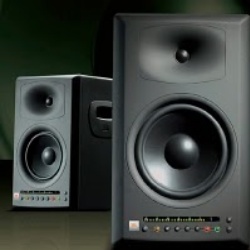
Take the trip to your local pro audio or music store and prepare to spend some time listening.
Listen to everything and spend as much time with each model as you can.
What should you listen for? Here’s how to evaluate a monitor:
—Listen for Even Frequency Balance: While listening to a piece of music that you know well, check to see if any frequencies are exaggerated or attenuated.
This is especially important in the mid-range cross-over area (usually about 1.5 to 2.5kHz). Listen especially to cymbals on the high end, vocals and guitars for the midrange, and bass and kick drum on the low end.
—Make Sure the Frequency Balance Stays The Same At Any Level: The less the frequency response changes as the level changes (especially when playing softly), the better. In other words, the speaker should have roughly the same frequency balance when the level is quiet as when it’s loud.
—Make Sure You Have Enough Output Level Without Distortion: Be sure that there’s enough clean level for your needs. Many powered monitors have built-in limiters that stop the speaker or amplifier from distorting, but also may keep the system from getting as loud as you might need them to be.
Above all, don’t buy a set of speakers without listening to them. It’s usually very difficult for them to live up to your expectations if you’ve not heard them first.
In fact, it’s not a good idea to buy any speaker unless you’re really in love with them. You’ll have to listen to these monitors for a lot of hours so you might as well like what you hear.
3) Listen with source material that you know very well. The only way to judge a monitor is to listen to material that you’re very familiar with and have heard in a lot of different environments. This will give you the necessary reference point that you need to adequately judge what you’re listening to.
I like to use some things that I’ve recorded myself that I know inside and out, and at least one favorite CD that I consider to be well recorded.
Remember – no MP3s here. Use only CDs or a playback system with an even higher quality 24 bit source like a personal digital recorder. That should give you some idea of the frequency response of the system.
Before the trend in monitors turned towards powered speakers, many engineers also brought their own amplifiers to the audition. This is because the amp/speaker combination is a delicate one, with each speaker having a much greater interdependence on the power source than most of us realize.
In fact, the search for the perfect amplifier was almost as long suffering as the search for the perfect monitor. All of this has dwindled in recent years, thanks to monitors with built-in amplifiers perfectly matched to its speaker drivers by the manufacturer.
One of the things that I learned in my frequent speaker auditions for EQ magazine over the course of five years is that you can easily get used to just about any speaker if you use it enough and learn it’s strengths and weaknesses.
It also helps to have a solid reference that you’re sure of to compare the sound with. For instance, if you know how things sound in your car, then adjust your mixes so they work when you play them there.”
Bobby Owsinski is an author, producer, music industry veteran and technical consultant who has written numerous books covering all aspects of audio recording. For more information be sure to check out his website and blog.
